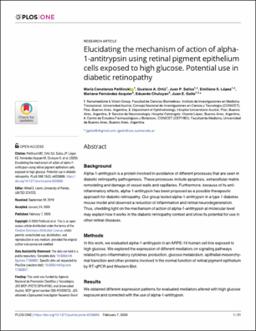| dc.description.abstract | Abstract
Background: Alpha-1-antitrypsin is a protein involved in avoidance of different processes that are seen in diabetic retinopathy pathogenesis. These processes include apoptosis, extracellular matrix remodeling and damage of vessel walls and capillaries. Furthermore, because of its anti-inflammatory effects, alpha-1-antitrypsin has been proposed as a possible therapeutic approach for diabetic retinopathy. Our group tested alpha-1-antitrypsin in a type 1 diabetes mouse model and observed a reduction of inflammation and retinal neurodegeneration. Thus, shedding light on the mechanism of action of alpha-1-antitrypsin at molecular level may explain how it works in the diabetic retinopathy context and show its potential for use in other retinal diseases.
Methods: In this work, we evaluated alpha-1-antitrypsin in an ARPE-19 human cell line exposed to high glucose. We explored the expression of different mediators on signaling pathways related to pro-inflammatory cytokines production, glucose metabolism, epithelial-mesenchymal transition and other proteins involved in the normal function of retinal pigment epithelium by RT-qPCR and Western Blot.
Results: We obtained different expression patterns for evaluated mediators altered with high glucose exposure and corrected with the use of alpha-1-antitrypsin.
Conclusions: The expression profile obtained in vitro for the evaluated proteins and mRNA allowed us to explain our previous results obtained on mouse models and to hypothesize how alpha-1-antitrypsin hinder diabetic retinopathy progression on a complex network between different signaling pathways.
General significance: This network helps to understand the way alpha-1-antitrypsin works in diabetic retinopathy and its scope of action. | en_US |


